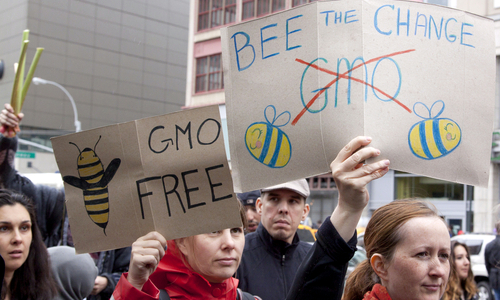
Bee Killers Sponsor National Pollinator Week (And 3 Ways They Are Killing Bees)

When Colony Collapse Disorder hit in 2006, others picked up where Kaatz left off.
In 2010, Terrence N. Ingram, a commercial beekeeper for 55 years, published an article in 2010 in Mother Earth News that detailed the struggles he’d had since his neighbors started spraying Roundup on their genetically engineered herbicide-tolerant soy in 1996. He went from producing 15 tons of honey a year down to four.
“The bees never had a chance,” he wrote, “and all of the hives were dead before winter.”
In 2012, his bees disappeared while he was out of town. This time it wasn’t the neighbor’s herbicide sprays, it was the Illinois Department of Agriculture (IDA). Under the pretense that Ingram’s hives were infected with foulbrood, the agency destroyed them to prevent the spread of the disease.
Ingram believed IDA’s action had more to do with his 15 years of research into the effect of Roundup on honeybees. His suspicions were fueled by the fact that IDA’s theft included the hive of a queen bee that may have had a genetic resistance to Roundup.
“Knowing that Monsanto and the Department of Agriculture are in bed together, one has to wonder if Monsanto was behind the theft to ruin my research that may prove Roundup was, and is, killing honeybees,” Ingram told local Prairie Advocate reporter Tom Kocal.
Ingram hasn’t been able to get his bees back. But his hunch that Roundup was killing his bees is gathering support.
The suspicions voiced in Ingram’s 2010 Mother Earth News article were backed up with scientific evidence in 2013, when plant pathologist Dr. Don Huber published a paper written for the Center for Honeybee Research that names glyphosate, the main ingredient in Monsanto’s Roundup, as a possible cause of Colony Collapse Disorder.
According to Huber, “The exposure, physiological damage, and biological impact of glyphosate are consistent with all of the known conditions related to CCD. Of all of the potential individual factors implicated in CCD, glyphosate is the only compound extensively used worldwide where CCD occurs that impacts all of them.”
2. Monsanto’s insecticide-producing, genetically engineered “Bt” Crops
In research from 2001-2004, Hans-Hinrich Kaatz conducted another investigation into the impact of Monsanto’s genetically engineered crops on honeybees. This time, he looked at “Bt crops” that have been genetically engineered to produce insecticide.
Kaatz found that genetically engineered Bt toxin didn’t kill healthy honeybees.
But as it turned out, not all the bees in his study were healthy. Just by chance, some of the bees were simultaneously exposed to a parasite along with the engineered toxin. In that group, there was a “significantly stronger decline in the number of bees.” According to Kaatz, the bacterial toxin in the genetically modified corn may have “altered the surface of the bee’s intestines, sufficiently weakening the bees to allow the parasites to gain entry.”
Because of the harmful effect that the pollen of Bt crops could have on bees, in 2012, Poland’s Agriculture Minister Marek Sawicki imposed a complete ban on growing MON810 corn, a Bt crop that is the only genetically engineered crop grown in the EU.
3. Monsanto’s genetically engineered seeds treated with Bayer’s insecticides
Looking at the science, it’s hard not to wonder if Monsanto isn’t killing bees intentionally. Especially when the company buys out a bee research firm and proposes use genetic engineering to address Colony Collapse Disorder.
It’s bad enough that Monsanto produces genetically engineered crops that screw with honeybees’ gastrointestinal health, making them more susceptible to disease. But here’s the kicker: Monsanto also treats its genetically engineered seeds with a class of systemic insecticides that’s straight-up toxic to bees.
Insecticides known as neonicotinoids, or “neonics” for short, are the smoking gun of Colony Collapse Disorder. Bee colonies began disappearing in the U.S. one year after the U.S. Environmental Protection Agency allowed these new insecticides on the market in 2004-2005.
A pile of studies implicate neonics in bee die-offs. Neonics are nerve poisons that disorient bees so they can’t make it back to the hive. They also trigger immune system failure, causing the bees to fall prey to opportunistic infections. Last year, the EU imposed a two-year ban on all neonics.
Monsanto routinely treats its seeds with neonics. Unlike insecticide sprays, neonic seed treatments cause the insecticide to spread through every cell of the plant as it grows. The insecticide is present and active in the plant’s pollen and nectar.
Take something that’s toxic to bees, get it to grow in plants’ pollen and nectar, and you’ve got a bee-killing machine.
Monsanto has a partner in this crime. It’s Bayer, the main manufacturer of neonic insecticides, as well as Syngenta, who together with Bayer controls the neonic market. They’re partners in Pollinator.org, part of their massive public relations disinformation campaign to distract the public and policymakers from thinking that pesticides might have something to do with bee death and destruction.
We can’t let these companies control what the American public knows about Colony Collapse Disorder. Celebrate National Pollinator Week by exposing their crime and the cover-up. Share this article and make plans to join the Global Swarm to Save the Bees on Aug. 16.
Alexis Baden-Mayer is political director of the Organic Consumers Association. Ronnie Cummins is national director of the Organic Consumers Association.

 233k
233k  41k
41k  Subscribe
Subscribe 